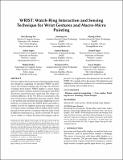Files in this item
WRIST : Watch-Ring Interaction and Sensing Technique for wrist gestures and macro-micro pointing
Item metadata
| dc.contributor.author | Yeo, Hui Shyong | |
| dc.contributor.author | Lee, Juyoung | |
| dc.contributor.author | Kim, Hyung-il | |
| dc.contributor.author | Gupta, Askar | |
| dc.contributor.author | Bianchi, Andrea | |
| dc.contributor.author | Vogel, Daniel | |
| dc.contributor.author | Koike, Hideki | |
| dc.contributor.author | Woo, Woontack | |
| dc.contributor.author | Quigley, Aaron John | |
| dc.date.accessioned | 2019-10-02T15:30:02Z | |
| dc.date.available | 2019-10-02T15:30:02Z | |
| dc.date.issued | 2019-10-01 | |
| dc.identifier | 260975359 | |
| dc.identifier | d2e5257d-7eee-4ef3-a827-f88f3e2f7687 | |
| dc.identifier | 85073533986 | |
| dc.identifier | 000556723600019 | |
| dc.identifier.citation | Yeo , H S , Lee , J , Kim , H , Gupta , A , Bianchi , A , Vogel , D , Koike , H , Woo , W & Quigley , A J 2019 , WRIST : Watch-Ring Interaction and Sensing Technique for wrist gestures and macro-micro pointing . in Proceedings of the 21st International Conference on Human-Computer Interaction with Mobile Devices and Services (MobileHCI '19) . , 19 , ACM , New York , 21st International Conference on Human-Computer Interaction with Mobile Devices and Services (MobileHCI 2019) , Taipei , Taiwan , 1/10/19 . https://doi.org/10.1145/3338286.3340130 | en |
| dc.identifier.citation | conference | en |
| dc.identifier.isbn | 9781450368254 | |
| dc.identifier.other | ORCID: /0000-0002-5274-6889/work/62668408 | |
| dc.identifier.uri | https://hdl.handle.net/10023/18599 | |
| dc.description | Funding: Next-Generation In-ormation Computing Development Program through the National Research Foundation of Korea (NRF) funded by the Ministry of Science, ICT (NRF-2017M3C4A7066316) and Institute of Information & communications Technology Planning & Evaluation (IITP) grant funded by the Korea government (MSIT) (No.2019-0-01270, WISE AR UI/UX Platform Development for Smartglasses). | en |
| dc.description.abstract | To better explore the incorporation of pointing and gesturing into ubiquitous computing, we introduce WRIST, an interaction and sensing technique that leverages the dexterity of human wrist motion. WRIST employs a sensor fusion approach which combines inertial measurement unit (IMU) data from a smartwatch and a smart ring. The relative orientation difference of the two devices is measured as the wrist rotation that is independent from arm rotation, which is also position and orientation invariant. Employing our test hardware, we demonstrate that WRIST affords and enables a number of novel yet simplistic interaction techniques, such as (i) macro-micro pointing without explicit mode switching and (ii) wrist gesture recognition when the hand is held in different orientations (e.g., raised or lowered). We report on two studies to evaluate the proposed techniques and we present a set of applications that demonstrate the benefits of WRIST. We conclude with a discussion of the limitations and highlight possible future pathways for research in pointing and gesturing with wearable devices. | |
| dc.format.extent | 15 | |
| dc.format.extent | 10780574 | |
| dc.language.iso | eng | |
| dc.publisher | ACM | |
| dc.relation.ispartof | Proceedings of the 21st International Conference on Human-Computer Interaction with Mobile Devices and Services (MobileHCI '19) | en |
| dc.rights | Copyright © 2019 Association for Computing Machinery. This work has been made available online in accordance with publisher policies or with permission. Permission for further reuse of this content should be sought from the publisher or the rights holder. This is the author created accepted manuscript following peer review and may differ slightly from the final published version. The final published version of this work is available at https://doi.org/10.1145/3338286.3340130 | en |
| dc.subject | Smartwatch | en |
| dc.subject | Wrist gesture | en |
| dc.subject | Distal pointing | en |
| dc.subject | Large displays | en |
| dc.subject | QA75 Electronic computers. Computer science | en |
| dc.subject | T Technology | en |
| dc.subject | NDAS | en |
| dc.subject.lcc | QA75 | en |
| dc.subject.lcc | T | en |
| dc.title | WRIST : Watch-Ring Interaction and Sensing Technique for wrist gestures and macro-micro pointing | en |
| dc.type | Conference item | en |
| dc.contributor.institution | University of St Andrews.School of Computer Science | en |
| dc.identifier.doi | 10.1145/3338286.3340130 | |
| dc.date.embargoedUntil | 2019-10-01 |
This item appears in the following Collection(s)
Items in the St Andrews Research Repository are protected by copyright, with all rights reserved, unless otherwise indicated.

